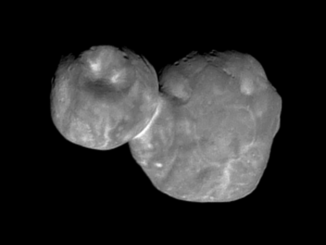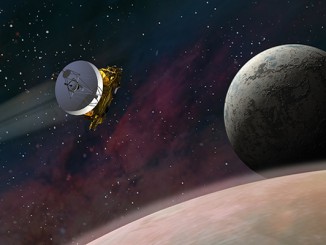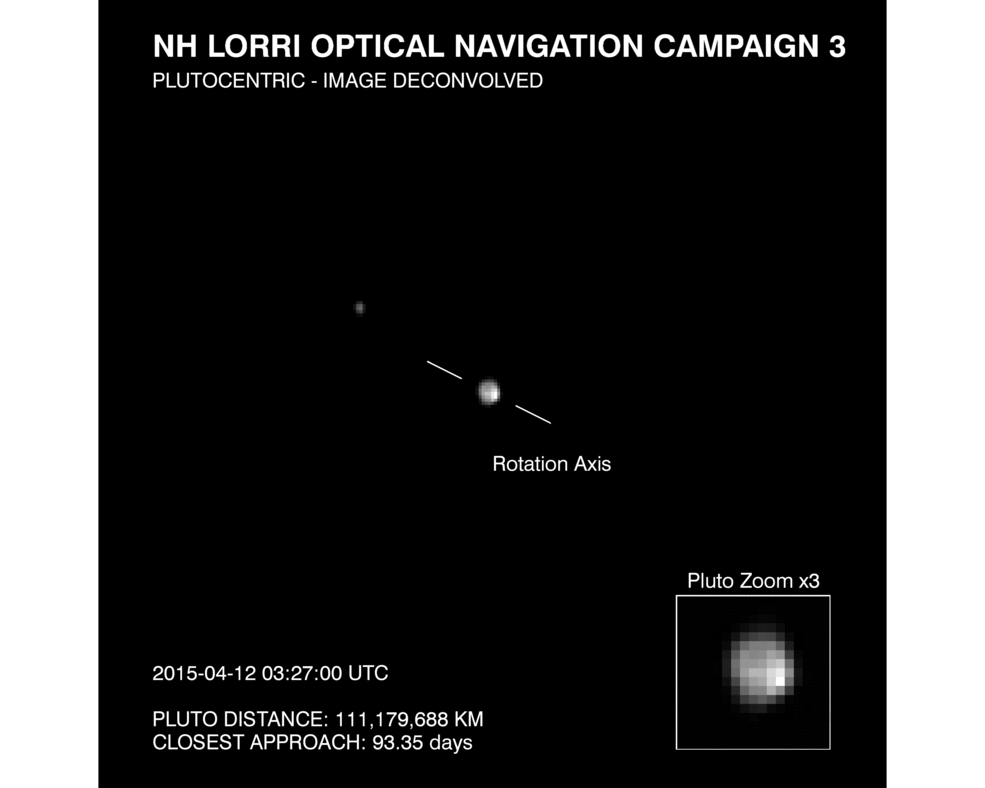
Alan Stern, chief scientist on NASA’s New Horizons mission, said Wednesday he had an emotional “meet Pluto moment” when new imagery from the faraway space probe arrived on Earth showing the mysterious world in more detail than ever before seen by human eyes.
“These images are just a little bit better than anything that’s been obtained in history,” Stern said in a conference call with reporters Wednesday unveiling fresh views of Pluto and its moon Charon.
The two worlds are locked in a cosmic dance, with the Texas-sized moon Charon tugging at Pluto as it flies around the bigger planet.
The imagery released Wednesday show bright and dark splotches on Pluto, and an animation reveals the motion of Pluto’s rotation around its pole and the track of Charon in orbit. Pluto is tilted on its side from the perspective of New Horizons, so one of the icy world’s poles is pointed at the approaching space probe.
“Imagine Pluto on its side, you’re looking down essentially on the pole, and it’s rotating before us like a chicken on a barbecue spit, an almost perpendicular rotation to our line of sight,” said Stern, a researcher based at the Southwest Research Institute in Boulder, Colorado. “Those features are real features on the surface of Pluto, seen for the first time by the New Horizons spacecraft.”
The New Horizons spacecraft’s long-range telescopic camera took the black-and-white images in mid-April at a range of less than 70 million miles from its target, and experts processed the raw imagery to tease out additional information on Pluto’s surface features.
“We’re just crossing the boundary where were able to do new science with images like this,” Stern said. “What they confirm for us is the strong albedo (reflectivity) differences across Pluto’s surface that were first detected by Hubble around 20 years ago.”
Stern described broad surface markings spotted by New Horizons on Pluto’s surface for the first time.
“There are structures hundreds of miles across that are coherently rotating around the equatorial zone,” Stern said. “The images always remain bright at the 3 o’clock position. That’s the pole, and that may be evidence for a polar cap and that would be very, very exciting.”
The bright reflections could be from an ice sheet at the pole. Spectroscopic observations from Earth-based telescopes show solid evidence Pluto contains three types of ices: frozen nitrogen, carbon dioxide and methane.
The nuclear-powered New Horizons spacecraft — about the size and shape of a grand piano — will be close enough to Pluto in the coming months to confirm the presence of a polar ice cap.
“For now, we can only say that it’s very suspiciously suggestive of a polar cap,” Stern said. “But we need that compositional data to really determine that.”
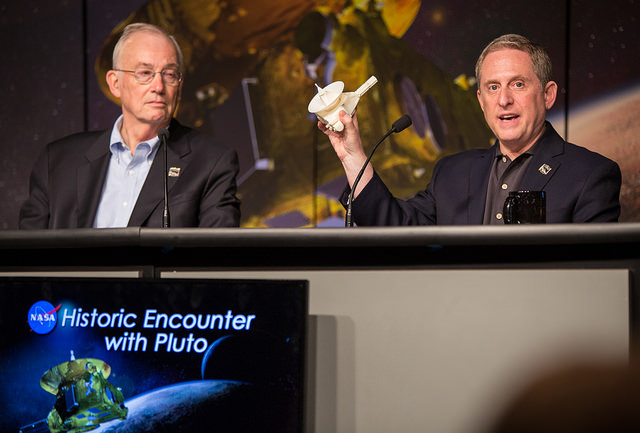
New Horizons will get better views as it barrels toward Pluto, heading for a one-shot flyby 7,800 miles from the dwarf planet’s surface July 14. The encounter will be the first time a spacecraft has ever visited Pluto, which orbits more than 3 billion miles from the sun.
Scientists look forward to seeing features on Pluto smaller than a city block during New Horizons’s fleeting flyby in July.
“Ultimately, we’ll get everything (on Pluto) at least at some resolution,” said Hal Weaver, the New Horizons mission scientist at the Johns Hopkins Applied Physics Laboratory, which operates the spacecraft for NASA.
“The polar cap is a region that’s normally a little bit colder than the rest of the surface and that’s where these volatile ices can condense on the surface,” Weaver told reporters Wednesday. “That’s what we think we’re seeing, but in the next month-and-a-half, we’re going to actually map with 60,000 pixels across the surface, and so we’ll be able to tell whether or not there’s really ice — whether those brightest regions are really ice and snowy patches.
“These are guesses at this point, and that’s the reason why we’re doing this mission,” Weaver added.
The images distributed Wednesday are sharper than the best photos ever taken by the Hubble Space Telescope, officials said, and they mark the transition of Pluto and Charon an astronomical target visible only through powerful observatories to an object with apparent geologic and topographic diversity.
The camera on New Horizons is still not as sensitive to faint objects as Hubble, so the speedy space probe has not yet detected Pluto’s four tiny moons much smaller than Charon. New Horizons will look for more moons of Pluto over the next three months.
“They are not dots in the distance any longer,” Stern said of Pluto and Charon. “We are now close to enough to resolve surface features.”
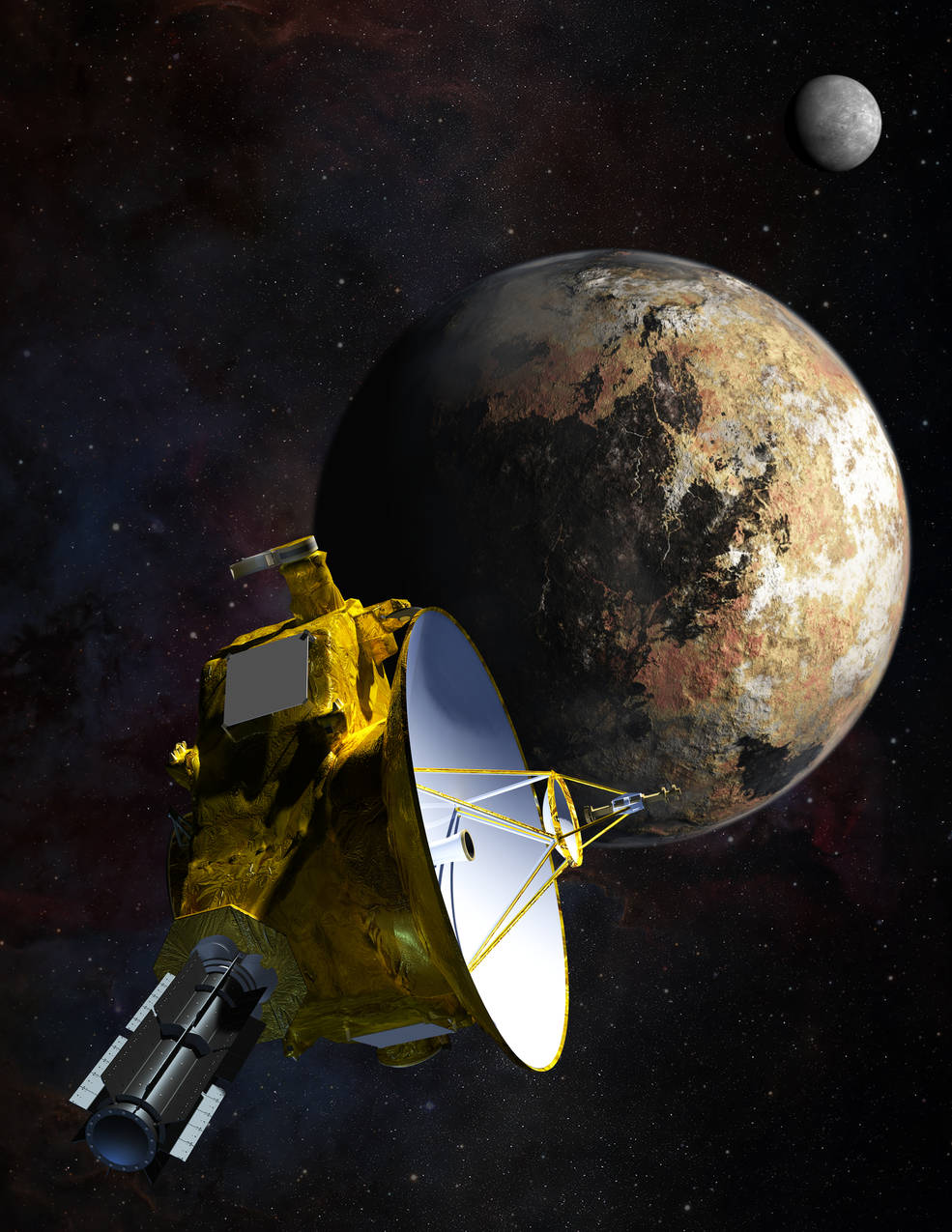
New Horizons launched from Cape Canaveral in January 2006, becoming the fastest vehicle ever sent into space. The spacecraft crossed the orbit of the moon in 11 hours and reached Jupiter 13 months after launch for a gravity assist to swing its path toward Pluto.
Stern, who has led the mission since NASA approved it in 2001, said he had a “meet Pluto moment” when he saw the latest images from New Horizons.
“Seeing it go from a point of light to an actual place that we’re approaching was actually a little bit emotional,” Stern said.
“As a planetary scientist, it’s rare to see any planet in the solar system at this low resolution displaying such strong suface markings,” Stern said. “If you had similar images of Mercury, or images of even Mars, for example, you would not see the same kinds of big surface units going by as you do here on Pluto. That’s very proimisnig for the imagery as we get closer and closer. It’s a mystery whether these bright and dark regions are caused by geology, by topography or by composition (variations).”
New Horizons will find out as it nears the July 14 flyby, when Pluto will more than fill the field-of-view of the probe’s long-range camera and a color imager will take its own pictures.
Scientists expect Pluto to have a reddish hue when New Horizons resolves the world’s color, and the dark regions observed by New Horizons may be the signature of organic compounds, Weaver said
“We’ve known from ground-based spectroscopy, as well as from recent images made in April that we returned from New Horizons, that Pluto’s color is somewhat reddish — not a deep red but a light red — but very reflective,” Stern said. “On the surface, there appears to be strong color gradients, different units with different colors.”
Weaver said the New Horizons probe’s LORRI camera, which took the pictures released Wednesday, will begin daily observations of Pluto on May 28. Mission officials plan to release raw images of Pluto on a public website within 48 hours of their downlink to Earth.
Follow Stephen Clark on Twitter: @StephenClark1.


